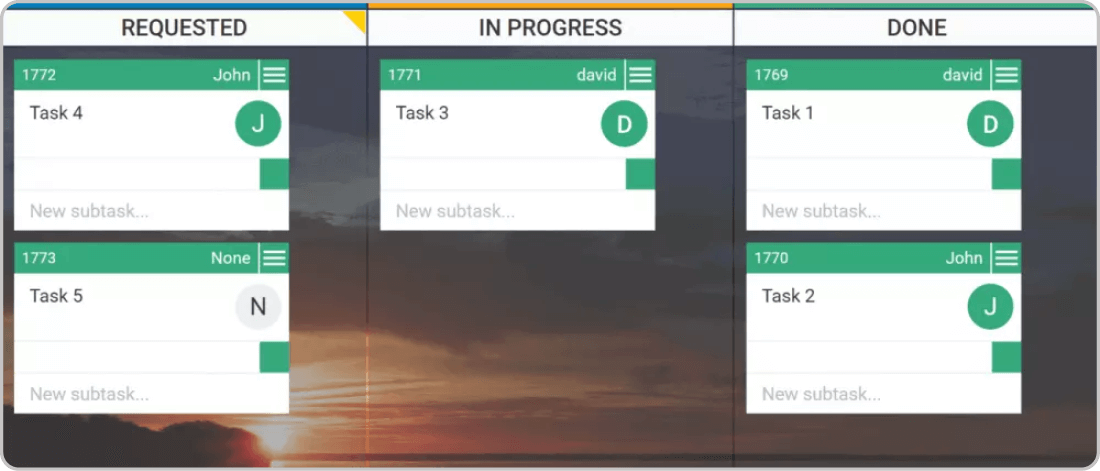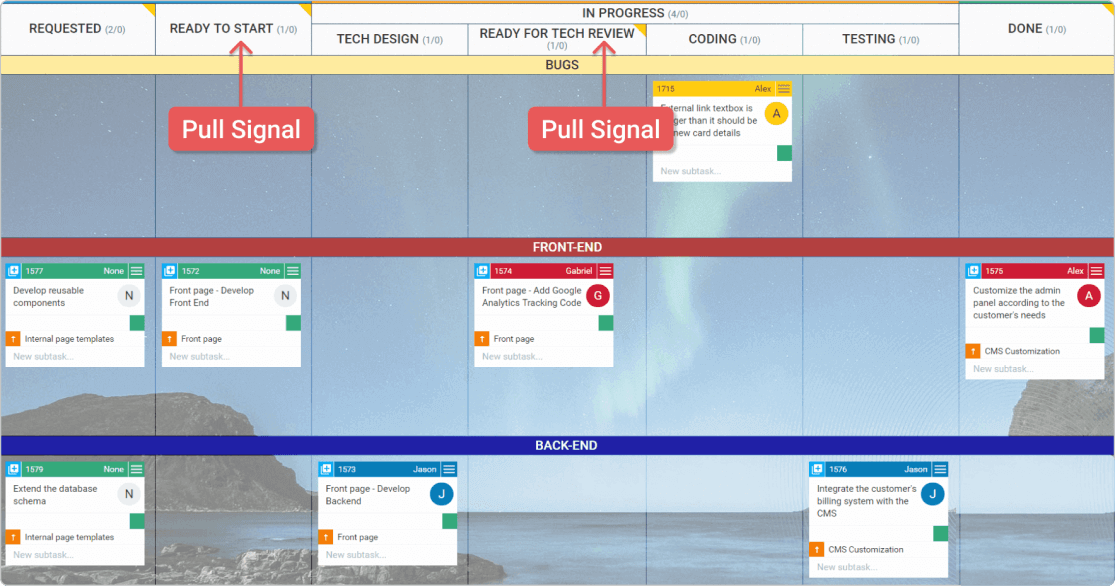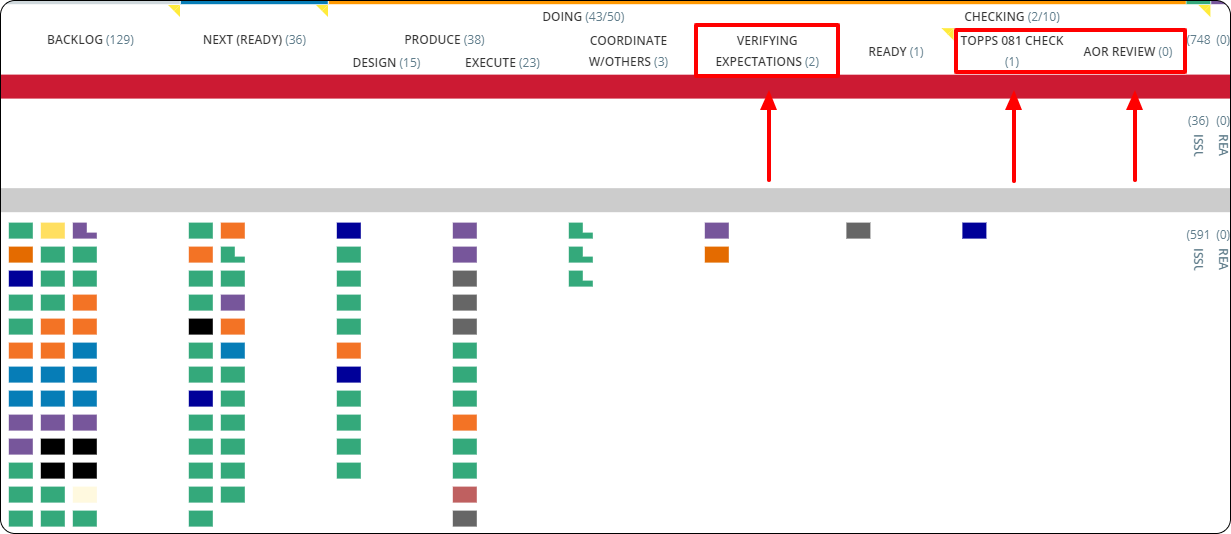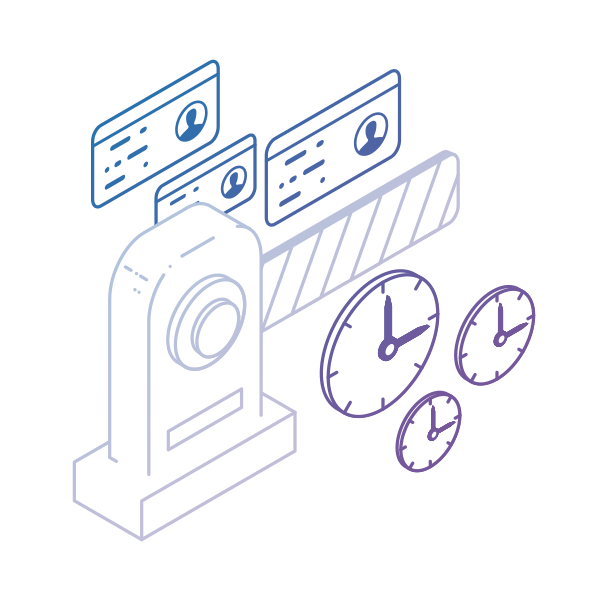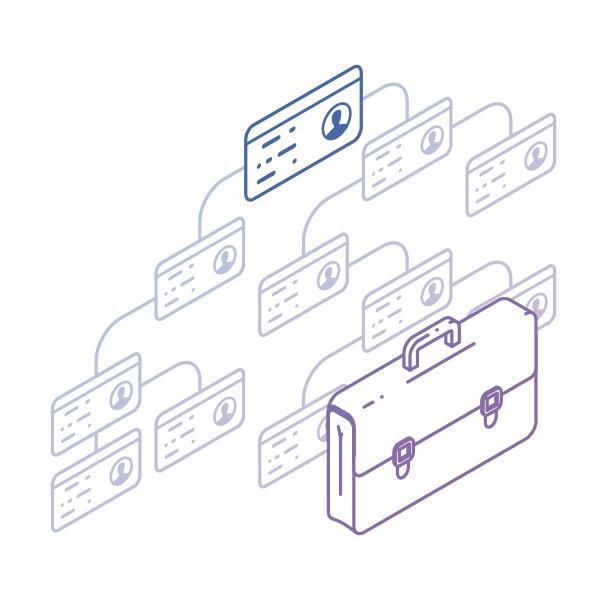Kanban, a term originating from Japan, has become synonymous with the visual management system used in manufacturing and knowledge work to improve productivity and efficiency.
In recent years, the Kanban pull system has gained popularity among businesses as a means of managing workflow by allowing teams to visualize their work, set priorities, and improve communication.
In the process of getting the hang of Lean management, you will learn that establishing a pull system of work is among the most important prerequisites to achieving optimal process efficiency.
Pull is a powerful concept that will allow you to take control of your workflow and deliver value to your customers precisely when it counts. As we’ve already covered what a pull system is, we’ll show you how to establish and maintain one with the Kanban method's help.
What Is a Kanban Pull System?
A Kanban pull system is a work management technique originating from Lean manufacturing that uses visual signals to indicate when items should be produced or moved. It is a demand-driven system that aims to eliminate waste by producing only what is needed when it is needed and in the amount required (just-in-time production).
The system relies on using Kanban cards to trigger the production or movement of work items in the production process. The goal of a Kanban pull system is to create a smooth and efficient workflow, minimize inventory, and reduce lead times.
Nowadays, the Kanban pull system is widely used by organizations for project management, product development, knowledge work management, and across industries, including pharma, banking, architecture, etc.
Why Use Kanban to Establish Pull Systems?
Kanban is the original and, by far, the most popular method for applying a pull system. It was part of the Toyota Production System that brought attention to the lean way of managing work.
What makes Kanban so suitable for running a pull system is its simplicity. The method is built on a short set of Kanban principles and practices that are easy to teach and do not require a colossal change from the beginning.
Many teams fail to understand that Kanban is more than just a set of boards and cards. If you want to implement a Kanban pull system successfully, your team needs to stick with the six core practices of the Kanban method:
- Visualize the workflow
- Eliminate interruptions
- Manage flow
- Make process policies explicit
- Maintain open feedback loops
- Improve collaboratively
How to Implement a Kanban Pull System?
To implement a Kanban pull system in your process, you need to follow three key steps. These steps will determine whether your implementation will be successful or not.
Step 1: Map Your Workflow
Visualizing your workflow is the foundation of Kanban and a vital part of keeping your pull system efficient. You need to be as precise as possible when preparing your Kanban board.
The default board setup consists of 3 sections representing your workflow states (requested, in progress, done). You need to carefully consider every part of your process and determine the steps of each stage.
Typically, you would like to break down the In progress stage into as many steps as possible to view your workflow and instantly spot any problems comprehensively.
Step 2: Establish Pull
After your boards are set up and ready for action, you should stop pushing new work in your process and start pulling only when there is a demand for it.
This will allow you to reduce your assignments' cycle time by focusing on work that will bring value to your customers just at the right time. As a result, you will be able to increase your process's efficiency and lower inventory costs.
Step 3: Limit Work in Progress
Even if you pull new work when there is a demand for it, your process may get clogged and stay inefficient. To be lean and make your Kanban pull system count, you need to control the amount of work that gets in and out of your workflow.
For this purpose, you need to place limits on the work in progress (WIP) and make sure that your team complies with them. You may set up such limits per person, work stage/column, or on a global scale for the whole board. Using token-based WIP limits, you can also restrict the utilization of given resources (ex., machines) in your process.
Your goal here is to reduce the lead time of your work items and make your flow as smooth as possible. For this to happen, you need to help your team focus. Encourage them to simultaneously work on as few tasks as possible to avoid switching contexts.
How to Manage a Kanban Pull System?
After you’ve got your Kanban pull system up and running, you need to address another key aspect of Lean management – continuous improvement. As a manager, you should closely examine your process and make adjustments whenever needed. Here’s how you can approach this in a few steps.
Step 1: Break Down Work
Keeping your flow smooth and running requires you to take good care of the cycle time of all cards that pass through your Kanban boards.
As you would want to reduce cycle times as much as possible, we advise you to break down your work into tasks that require no more than a few days to move from requested to done.
This will allow your team to pull work more often from one stage to another and keep all parts of your process running. As a result, you will reduce the cycle times of your work assignments and increase the throughput of your pull system.
Step 2: Apply Pull Signals
Pull signals will allow your team to understand when a task is ready to be moved on to the next stage of your workflow. In Kanban, the simplest way to apply such signals is to dedicate a few columns.
Simple examples are the "review" columns that you should place after every specific activity that needs to be evaluated.

This will allow you to signal that a work item is ready to move on to the next stage and help you increase the built-in quality, as you’ll be able to ensure that there are no mistakes in the production process.
For example, in software development, you can break down your production process into three dedicated stages: tech design, coding, and testing. By adding a review step after every stage, you can ensure that all aspects are communicated and that there are no issues with the feature’s deployment. Placing a column such as "Ready for review" will create a pull signal, indicating that the person responsible for work evaluation needs to take action as soon as possible.
There are many other examples of applying a pull system in the knowledge work processes of different industries. Let’s take architecture, for instance.
Besides the "committed stage," where you plan the work to execute next, you can break down your workflow into a: "Working stage," where you design drawings, and a "Review stage," where different subject matter experts give their feedback. It's then important to study your process and apply WIP limits and pull signals such as buffer columns (ex. Ready for Review) to signal that a work item is ready to move forward so you can eventually smooth out your workflow.

Step 3: Manage Bottlenecks
Bottlenecks are an inevitable part of every process, no matter how advanced it is. They are a typical reason for failing to establish a smooth workflow. The issue with bottlenecks derives from the imbalance in the capacity of the distinct stages of your workflow.
For example, if you’ve got ten developers working on your new product release and only one person responsible for the code review stage, it will be no surprise that this will likely be your bottleneck stage.
Often the real problem with managing bottlenecks is that they are not visible. However, if you’ve mapped your workflow precisely on a Kanban board, they should be recognizable immediately.
After noticing that a stage is becoming a bottleneck, you should waste no time but analyze the root cause of the problem.
Afterward, you should take the proper measures to either eradicate the bottleneck or take action to prevent it from clogging your process and obstructing your flow.
Kanban Pull System Frequently Asked Questions (FAQs)
What Are Some Examples of a Kanban Pull System?
Stock management in supermarkets is a typical example of a Kanban pull system. When an item is in high demand, the system signals that it is running out and needs restocking. This way, supermarkets don’t overstock products that may go to waste and only replenish what is actually being sold, creating a lean and efficient supply chain.
Is Kanban a Push or Pull System?
Kanban is a pull-based method wherein work enters the process flow when there is explicit demand from customers. In Kanban, this is achieved by limiting the amount of work in progress (WIP) and only allowing new work to be pulled into the system when a slot is available. This creates a "just-in-time" system where work is only completed as needed rather than being pushed through the system regardless of demand. This helps to minimize waste and increase efficiency.
We offer the most flexible software platform
for outcome-driven enterprise agility.
In Summary
Kanban is the most popular way to establish and maintain a pull system, thanks to its simplicity and transparency. To apply a proper Kanban pull system, you need to:
- Map your workflow on a Kanban board.
- Establish a pull system.
- Limit the amount of work in progress.
- Break down large assignments into smaller tasks.
- Apply pull signals to your Kanban board.
- Manage your bottlenecks so your flow never gets stuck.





